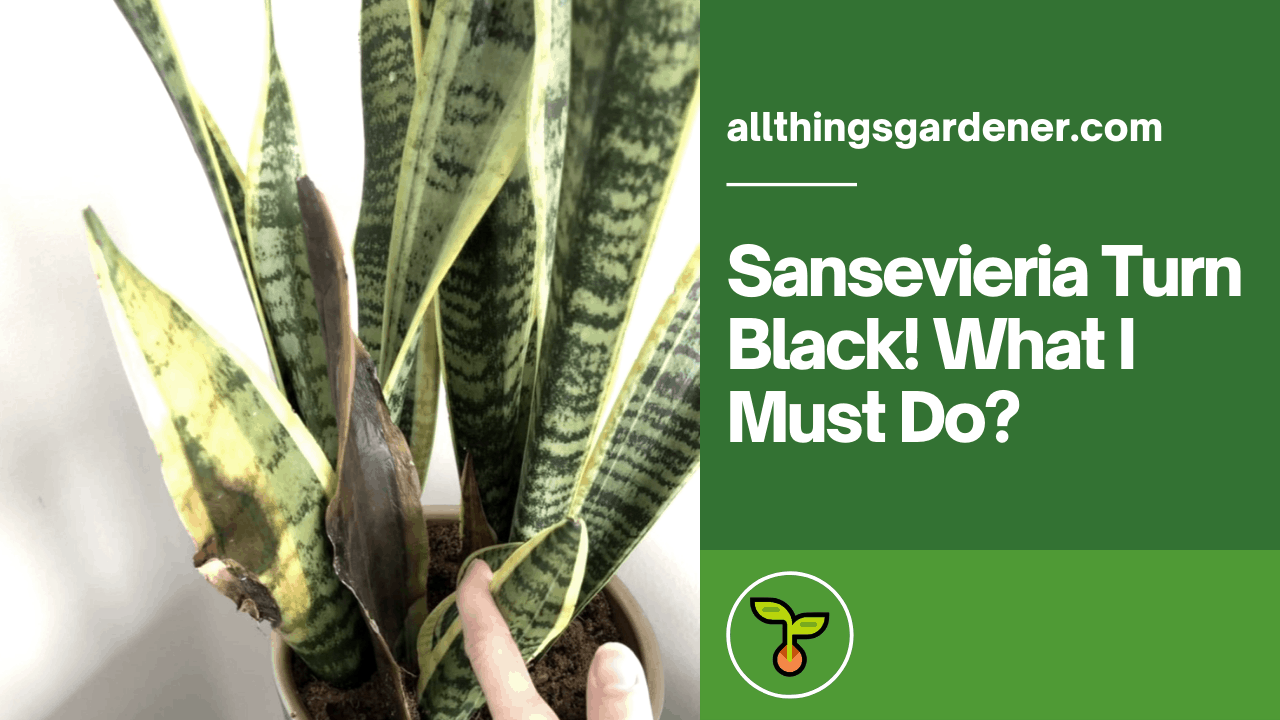
Snake Plant Turning Black?
Why My Snake Plant Turn Black?
Sansevieria or Snake plant turn black because of root rot caused by damp soil around the roots…
…over watering or high humidity. Snake plants require well draining soil and pots with drainage holes…
…to avoid root rot which turns the leaves black.
You can implement the best practices of care to prevent your snake plant’s leaves from turning black…
…as well as how to revive your snake plant, by reading this article.
Before that we have story from George about his experience encountering snake plant turn black.
Let us hear George’s story
I used to have a snake plant, it was my favorite houseplant and I just loved looking at the long leaves.
But then one day I noticed that they were turning black! It’s not like they were dying or anything but rather…
…becoming darker as the days went by. The more you look at them, your eyes would hurt because of how dark they are.
That’s when I knew that something must be wrong with them so decided to take them outside for some fresh air…
….and put some fertilizer on it, hoping this plant will grow big as ever.
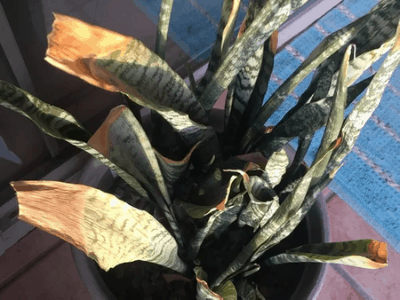
Too much water around the roots from frequent watering promotes the conditions for the fungal disease root rot which turns the snake plant leaves black.
Mark Bennett, author from gardenerreport.com
Here’s the main thing…
Over Watering Causes Snake Plants To Turn Black
The most common cause of snake plants turning black is over-watering. Snake plants are native to Africa…
…where they grow in drought-like conditions with infrequent rainfall. If you water your snake plant…
…more than once a week, then you are over watering your snake plant. It is particularly important…
…to water snake plants once a month in the Winter months when snake plants go dormant and stop growing,
drastically reducing their demand for moisture.
During these months, you need to encourage healthy roots with a good soak to prevent root rot.
The reason why your snake plant is not growing is rooted in water too near the roots…
…which promotes the fungus root rot, which turns the snake plant leaves black.
To rectify this, water with low pressure around the roots.
The snake plant plant often turns yellow and droops as an early sign of over watering.
Black leaves tell you that root rot has already taken place. How to save it; Cut back on the watering.
Snake plants need to be watered with a cycle of soaking the soil, allowing it to dry completely…
…and then soaking it again. This replicates the conditions in its native environment.
Snake plants usually prefer watering once every two weeks, but the best way to determine…
…the correct watering frequency for your climate is to feel the soil through the drainage hole…
…in the bottom to determine whether it’s dry or damp. Please see my article on how often to water snake plants…
….if the leaves are dry, or if they are still moist wait until they are dry before watering.
Once decay has set in, it can be very difficult to revive a snake plant. The best way to prevent the spread of black rot…
….is to remove any sections of black from your snake plant and replace only healthy tissue.
Without treatment, it will eventually kill your snake plant. Once the black parts of your snake plant are removed…
…and you have corrected your watering practices the plant should be able to grow again.
If there is significant blackness on the snake plant then it can be impossible to revive and most likely the plant…
…will die back. If there is any healthy tissue on the plant then I recommend taking cuttings for propagation.
Propagating snake plant from cuttings is very easy and has a high success rate.
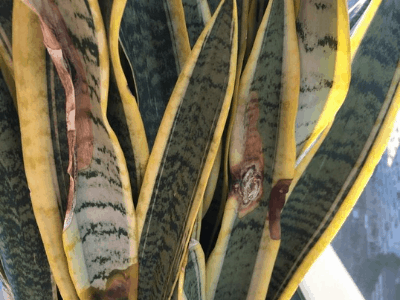
Go on…
Slow Draining Soils
A snake plant can be found in gritty soil that naturally drains quickly and doesn’t hold onto much moisture.
The snake plant leaves are likely to turn black if they are planted in ordinary potting soil…
…because this is likely to retain too much moisture around the roots of your snake plant.
A well draining soil mimicking the well draining qualities of the soil they grow in in their native environment is critical for snake plants.
Snake plants grow well in specially blended succulent and cactus soil available on Amazon and in garden centers.
They are formulated with specific drainage features for snake plants to ensure water percolates…
…up to the roots but drains quickly to avoid root rot. Replacing potting soil with some succulent and cactus soil…
…can prevent further stress to the plant. If your potting mix stays moist for long periods of time after watering…
….this may signal that the soil is getting too heavy. Regardless of the right watering frequency and a well-draining…
…potting mix, you still need to remove any black parts of leaves entirely to prevent the rot spreading…
…and for the plant to recover. Although it is advisable to take any cuttings you can to propagate the plants…
….significant black snake plants will be harder to propagate.
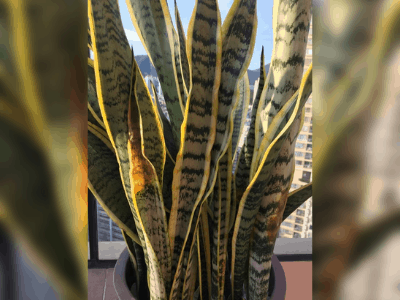
Next up…
Pots Without Drainage Holes in the Base Cause Water Stress
Because of water stress snake plant leaves can turn black because they are planted into pots with no drainage holes…
…at the base of the pots which causes water to pool around the roots.
Replanting a snake plant in one without drainage holes will allow for the plant to live longer.
Snake plant leaves turning black is not only the fault of pots without drainage holes in the base.
Use of saucers, tray, etc. Under your pot of plants, if there is a saucer or tray to prevent water splashing from spilling…
…the saucer or tray should be emptied regularly, as this keeps the soil wet and causes root rot.
Snake plants are typically sold in store as gifts with a decorative outer pot.
This pot can prevent excess moisture from escaping and cause the soil to stay damp…
…causing water stress and snake plant leaves to turn black. A decorative pot without drainage holes in the base…
…is ideal for snake plants. Snake plants require the soil to dry out in between waterings to prevent the leaves…
…from turning black, so it’s crucial to plant them in the correct pot and ensure that excess water can escape after watering.
For snake plants, which are water stressed because of any other reason, you should cut away any foliage…
…which turns black back to healthy tissue and propagate from cuttings if necessary.
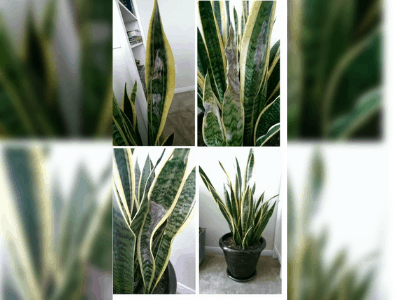
Last but not least…
Humidity Slows Water Loss from Leaves and Causes Black Leaves
It’s not uncommon for snake plants to prefer cool, dry environments and for a room of low humidity…
…to be preferred by them, since humidity can slow the rate of transpiration from their leaves.
This is how snake plants regulate their moisture levels. Due to the high humidity, less transpiration may occur….
…therefore changing the color of snake plants. Higher humidity may not just be the result of the climate, but also:
Watering leaves onto the leaves would be against the snake plants’ natural dryness.
When watering snake plants, make sure the water is at the base of the plant and not sprayed overhead.
Generally, snake plants do not like humid environments such as the bathroom or kitchen where…
…there is a lot of moisture in the air. Locate your snake plant in a dryer place.
Snake plants can struggle to grow in climates with high levels of humidity, so give them a shady spot if possible.
Keeping your snake plant in a low humidity room can help it recover from rot and prevent further damage to the leaves.
Sum Up
See having Snake plant is good choice for you to have! It’s cool, its famous, it’s easy to have and care!
What else do you need? In this pandemic time like this, is a good choice for you to have an new activity…
…and having snake plant is a good choice for you to have!
Conclusion
Last thing for sure. This plant need to be care carefully, remember plant need the “love” too.
Alright that’s all for today! Do you have any questions about all of this?
Or do you want to add some good method for caring and having baby snake plant?
Let me know your recommendation from the comment below.
I hope you can now take care your snake carefully and grow it big!
Thanks for reading this article! Bye!

